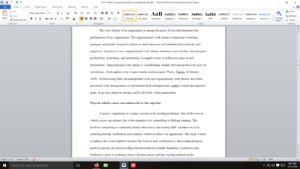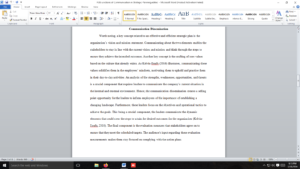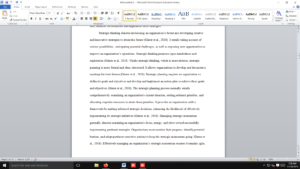Create a presentation (maximum of 20 slides with detailed speaker notes) for senior leadership in which four organizational leaders analyze the impact of a health care organization\’s new safety and quality dashboard. Include an analysis of what the new metrics mean and how they will inform departmental activities for the next quarter.
\”Being in a position of leadership is the most important job of any health professional anywhere along the continuum of care\” (Ledlow & Coppola, 2013, p. 3). Leaders and ultimately the boards of directors of health care organizations are accountable for the safety of those they serve.\” National quality organizations and regulatory bodies … are growing in their emphasis on leadership accountabilities for safe, reliable care as well as excellence in the experience of care\” (Youngberg, 2013, p. 39).
With this emphasis on leadership accountability for the delivery of safe, high-quality health care services, health care leaders need to be able to drill down on what exactly safety and quality mean in the health care environment. Likewise, they also need to be able to design measures that help to ensure their organizations are able to deliver those kinds of outcomes. Read Measurement Perspectives [PDF] to examine key elements related to this issue.
In this final course assessment, you will have a unique opportunity to examine a health care organization\’s safety and quality dashboard from the perspective of four organizational leaders. You will explore each leader\’s specific interests regarding patient safety and quality. In particular, you will have the opportunity to perform a more in-depth analysis of the dashboard, the type of analysis a quality director might perform to further the organization\’s safety and quality objectives.
References
Ledlow, G. R., & Coppola, M. N. (2013). Leadership for health professionals (2nd ed.). Burlington, MA: Jones & Bartlett Learning.
Youngberg, B. J. (2013). Patient safety handbook (2nd ed.). Burlington, MA: Jones & Bartlett Learning.
Demonstration of Proficiency
By successfully completing this assessment, you will demonstrate your proficiency in the course competencies through the following assessment scoring guide criteria:
- Competency 1: Analyze the quality and performance improvement activities within the health care organization.
- Recommend evidence-based actions to improve a selected measure on a health care organization\’s safety and quality dashboard.
- Competency 2: Explain the risk management function in the health care organization.
- Analyze areas of a safety and quality dashboard of concern to a risk manager.
- Competency 3: Analyze the importance of patient safety in health care.
- Describe how a health care organization chooses the metrics to include in its safety and quality dashboard.
- Analyze areas of a safety and quality dashboard of concern to a patient safety officer.
- Competency 4: Apply leadership strategies to quality improvement in a health care organization.
- Assess senior leadership\’s role in setting a health care organization\’s strategic safety and quality objectives.
- Competency 5: Communicate in a manner that is scholarly, professional, and respectful of the diversity, dignity, and integrity of others and is consistent with health care professionals.
- Create a clear, organized, persuasive, and generally error-free presentation on a leadership team\’s assessment of an organization\’s safety and quality dashboard that is reflective of professional communication in the health care field.
- Provide citations and title and reference pages that conform to APA style and format.
Preparation
To help prepare for successfully completing this assessment:
Instructions
Your organization has just updated its safety and quality dashboard. Please review the Vila Health Mercy Hospital Safety and Quality Dashboard [PDF]. Note: You do not need to create a dashboard for this assessment. You are simply being asked to work with the one provided.
The CEO has asked each of the organizational leaders below to prepare a joint PowerPoint presentation. In it, they are to prepare a set of slides outlining their analysis of how the new numbers will inform their particular activities for the next quarter. The organizational leaders include:
- The quality director.
- The patient safety officer.
- The risk manager.
- Senior leadership.
Because of the quality director\’s critical role in implementing the organization\’s safety and quality strategic objectives, this individual will open the presentation and provide additional background about how the new dashboard was developed. This individual will also close the presentation. Use the following outline to organize your presentation. Be sure to include the introduction and conclusion and address all the questions listed under these headings. Also be sure to address each role and the corresponding questions.
Introduction (3–4 slides)
- What is a safety and quality dashboard?
- What role do safety and quality dashboards play in helping health care organizations drive their strategic safety and quality objectives?
- How do health care organization determine what they want to measure? Be sure to consider:
- Pressures from regulators, payors, and the industry.
- Self-identified improvement areas. For example, one organization\’s safety and quality dashboard may highlight patient falls because its rate of falls is higher than the national average. This may also have resulted in increased costs to the organization.
- What CQI tools did the organization use to obtain, measure, and report data?
- What was the quality improvement team’s role in addressing the reported measures?
Quality Director (2–3 slides)
- Which metric on the dashboard would draw the quality director\’s attention the most?
- What does this dashboard metric mean and why is it important?
- What three recommendations to leadership would help to address this metric?
- What (if any) quality models could be used to increase the quality of patient care and outcomes for this metric? Consider PDCA, Six Sigma, Lean, Hoshin Kanri planning, et cetera.
Patient Safety Officer (2–3 slides)
- Which metric on the dashboard would draw the patient safety officer\’s attention the most?
- What does this dashboard metric mean and why is it important?
- What role does the patient safety officer play in improving this metric?
Risk Manager (2–3 slides)
- Which metric on the dashboard would draw the risk manager\’s attention the most?
- What does this dashboard metric mean and why is it important?
- What role does the risk manager play in improving this metric?
Senior Leader (1 slide)
- What is the role of senior leadership (for example, CEO, COO, president, senior VP) in driving safety and quality improvement initiatives?
- What next steps might senior leadership take given the dashboard findings and the quality director\’s three improvement recommendations?
Conclusion (2–3 slides)
- Which regulatory agency(ies) may be concerned about the findings in this dashboard?
- Why would regulators be concerned about these findings?
- Why are safety and quality dashboards important for monitoring key metrics in health care organizations?
Your slides need to be concise and offer main ideas in bulleted format. Use the speaker notes to expand upon your findings as if they were the transcript of your presentation for the leadership team.
In the health care environment, it is unlikely for a presentation and speaker notes to be in APA style. Do make sure they are concise, organized, clear, and free of errors in grammar, punctuation, and spelling. Do make sure they address all the required headings and all of the questions under each heading.
Your senior leaders will want to know the sources of your information. Be sure to cite your sources in APA style in your speaker notes.
Additional Requirements
- Presentation length: Your presentation should be a maximum of 20 slides, including title and reference slides. Format your title and reference slides according to APA format.
- Speaker notes: Be sure to include these with your slides. They provide an opportunity for you to expand on the information you are highlighting in your slides.
- Number of references: Cite a minimum of two references.
- Scoring Guide: Please read the scoring guide for this assessment so you understand how your faculty member is going to evaluate your work.
Answer preview
- The importance of safety and quality dashboards for monitoring key metrics is to improve healthcare safety
- Anther significance is to promote quality of care
- Also the dashboards aim to increase patient satisfaction
- This is crucial for setting a good public image and reputation
[Slide 19 0f 20]
 Training Plan Scoring Guide.
Training Plan Scoring Guide. Capella University Library.
Capella University Library. How Do I Find Peer-Reviewed Articles?
How Do I Find Peer-Reviewed Articles? The Writing Center.
The Writing Center. APA Style and Format.
APA Style and Format. APA Paper Template.
APA Paper Template. APA Paper Tutorial.
APA Paper Tutorial.





